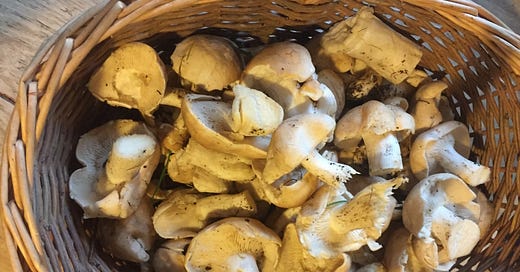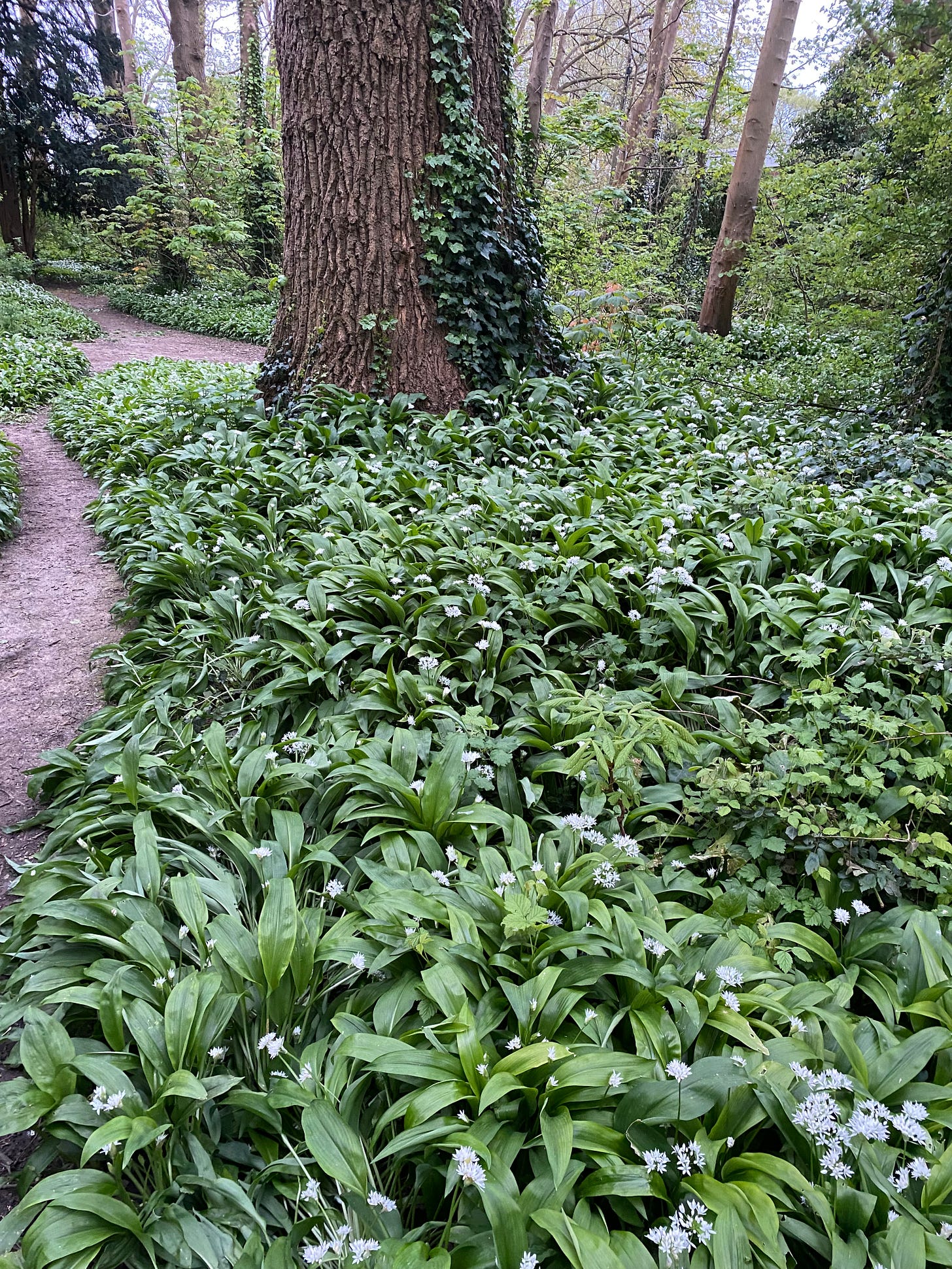St George’s Mushrooms gathered on the Isle of South Uist.
Easter Sunday is the first Sunday after the first full moon that occurs after the Equinox (the Paschal moon). It’s a moveable Christian celebration ranging from 22nd March to 25th April. Edible wild ingredients are seasonal but some years when the weather is clement wild food appears earlier than others. In a mast year the forager gathers a full basket in another year (famine) he or she must content themselves with paucity of ingredients (famine).The first of the spring fungi to appear is the St. George’s Mushroom Calocybe gambosaso . This mushroom is so named because it appears in early spring around St. George’s Day (23rd April).
St George is the patron saint of England and the Saint’s date was set in 1222. In about 1348, King Edward III founded the Order of the Garter (a noble brotherhood of European Knights) in his name. It is also the celebration of one of England’s poets and dramatists William Shakespeare’s, birthday (although he exact birth date is unknown). On the Sunday closest to St. George’s Day a festival is held in Shakespeare’s birthplace. The congregation leaves Holy Trinity Church Stratford Upon Avon to a tintinnabulation of church bells and follows a historic pageant to Shakespeare’s grave where flowers are laid. The story of St. George is that he saved a princess by slaying a dragon. A soldier in the Roman army, he refused to denounce his faith and fellow Christians, and was martyred in 303 A.D. Churches in England fly the flag of St. George from a church tower on April 23rd or indeed on any Parish festival day. A simple English flag celebrating England’s guardian saint.
In late April, Yellow Flags begin to peep through ditches on the Isle of South Uist. Foragers resident in the Frozen North are content to make elderflower cordial a good month later than those in the South of England and this goes for spying St George’s Mushrooms too. Let’s just say that in common with Easter, St George’s Mushroom picking dates will vary with geography and climate. It’s not a problem. All good things (with a big stir of luck) come to those who wait.
Spring brings blossom on the trees and a hint of real warmth in the sun. Hope. A promise of longer days and a summer to come. April is sometimes referred to as Earth Month, a time for reflection on the action needed to save our planet. Clean air and clean water for everyone. During Earth Month, as in every month, my foraging message is : harvest wild edibles sustainably - don’t pillage nature’s bountiful store.
Foraging mushrooms for the kitchen can be dangerous; one needs to be 100% sure of identification. Don’t munch on a hunch. In the words of Terry Pratchett : “All fungi are edible. Some fungi are only edible once.” Last year I picked St George’s mushrooms on May 6th. This year, I fear that I may be fortunate to find one, unless I put some foraging hours in. A local wayside has been accosted by a member of the ‘Neat and Tidy Garden Extension Society’. Cutting this verge is, in my opinion, of little benefit to the local community. Escaping rogue sheep are most helpful in preventing vegetation encroaching on to South Uist’s single-track roads. Who needs a noisy lawn-mower. I am in need of St George’s dragon or perhaps a deeper faith in my ability to find another mushroom patch. Foragers can be a tad on the lazy side and secretive too. There is a lesson here for me… it is / was not my St George’s patch. However, beyond mushrooms, the passer-by will now miss out on mauve Lady’s Smock (excellent in soups and salads), sorrel and later in summer, ragged robin et al, and all before one considers the bees and butterflies. I digress. I must leave this subject with the green infrastructure policy makers.
Lady’s Smock or Cuckoo Flower - recipes in The Forager’s Kitchen Handbook
The early hours are often rewarding to the mushroom hunter. The world is silent, and grass is still dew clad. If you find St George’s, you are a fortunate person. These pale cream mushrooms are delicious. They have a rather flour-like smell about them and in common with all wild plants and fungi, are excellent players of hide and seek. Once you get your foraging eye in, you will probably spy St Georges everywhere. Remember the spot and come back another year, unless of course, you are thwarted by an over adventurous gardener, as I have been. You may, with luck, even stumble across a St George’s fairy ring. The next lesson to learn is to avoid Dante’s fourth circle of avarice and greed. It’s tempting to pop just one more mushroom into your basket. Don’t. Wild anything seems to add kudos to a recipe. For a double foraging recipe win you could sauté your mushroom haul in butter with some finely chopped wild garlic (ramsons). There are of course more imaginative ideas. However, sauteed wild garlic and St George’s mushrooms on toast is fast, delicious, and seasonal.
Good Luck with hunting out St George’s Mushrooms on St George’s Day and into early June







